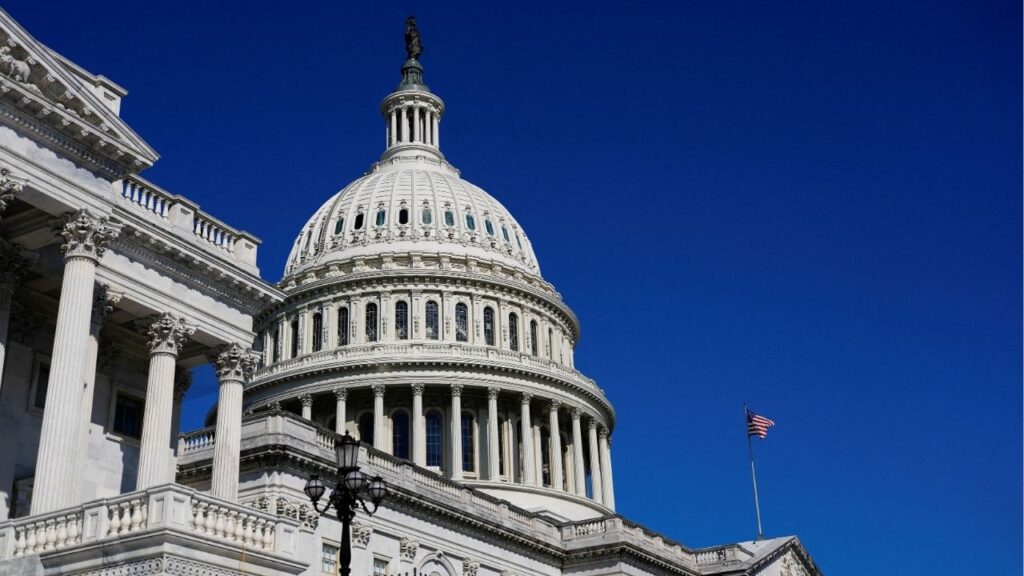Gov. Newsom’s latest budget proposal cuts the Middle Class Scholarship to $100 million. The Legislature wants to provide more than $900 million for it. (CalMatters/Semantha Norris)

- California's Democrat-controlled Legislature and Gov. Gavin Newsom face scrutiny over higher education budget plans.
- The Legislature advocates for Cal Grant expansion, potentially slashing the Middle Class Scholarship to $100 million annually.
- Newsom's plan proposes UC and CSU cuts, delays funding, but still aims to boost California resident enrollment.
Share
|
Getting your Trinity Audio player ready...
|
Within the next week and change, Democrats who control the Legislature and fellow Democrat Gov. Gavin Newsom will need to reconcile their competing budget plans for higher education in California, with huge implications for student financial aid and the short-term fiscal health of the state’s public universities.

Mikhail Zinshteyn
CalMatters
At issue is the 2024-25 state budget that begins July 1 and the multibillion-dollar projected deficits California faces. Lawmakers and the governor are in the final, secretive sprint of the annual process to craft the state government’s spending plan.
The Legislature fulfilled its constitutional duty last Thursday by passing its budget plan. That started the clock for Newsom and lawmakers to reach a compromise for the final 2024-25 budget by late June.
And on higher education, they’re far apart in key ways — differences that first emerged in January, when budget season publicly kicked off with Newsom’s first proposal for 2024-25.
“As depressed as I was in January, and as bad as some of the cuts still are that are included in this budget, in education I think we’ve been able to step ahead with this budget,” said John Laird, a senator and Democrat from Santa Cruz who is chair of the budget subcommittee on education, at a hearing on the Legislature’s budget last week.
Related Story: Gavin Newsom and Top Democrats Are Deciding California’s Budget Behind Closed ...
How Much for Middle Class Scholarship?
Newsom’s last public spending proposal, released in May, would permanently gut the Middle Class Scholarship to just $100 million annually — a serious blow to California’s dreams of supersizing college financial aid so that no university student would need to take out student loans.
The Legislature countered last week with a stark “nope,” instead keeping a past-year’s promise to grow the program to $926 million in 2024-25 and the following year.
The dueling proposals would either slash how much each of the roughly 300,000 student recipients who attend University of California and California State University would receive — or make debt-free college a closer reality.
Under the governor’s plan, average awards would drop from between $2,500 and $2,800 to just over $300. If the Legislature gets its way, average awards would range from $3,100 for UC students to $3,600 for Cal State students.
The cuts would likely mean more college loans for students, an official with the governor’s Department of Finance said at a hearing last month.
The Legislature’s plan “significantly brings back the Middle Class Scholarship, right at the time that parents and students are making decisions about what colleges to go to and whether they have the financial resources to go to certain public higher education institutions in California,” Laird said at the budget hearing last week.
Related Story: California Legislators Break with Gov. Newsom Over Loan to Keep Last Nuclear ...
Will Cal Grants Help More Students?
The Legislature also seeks to partially expand the Cal Grant, the state’s marquee financial aid program, for the 2025-26 budget year. If the plan is approved, another 21,000 students would receive the grant for the first time. About 400,000 students receive it currently.
Newsom in May formally rejected any expansion of the Cal Grant, citing California’s colossal fiscal hole. But legislative budget leaders have been adamant about rolling out the Cal Grant to more students despite the state’s difficult finances to make good on years of aggressive advocacy from lawmakers.
The cost would be $47 million in one-time funding to ensure current students receiving the Cal Grant under the current rules would remain in the program.
If the plan becomes law, about 11,000 more community college students would get the grant in 2025-26, which would appear as a cash award of about $1,650 and then cover tuition at a UC or Cal State if the student transfers. Cal Grants are valid for four years of full-time enrollment. The number of new recipients would grow with each subsequent year.
This is a lower number of new recipients, and smaller price tag, than what’s in the original Cal Grant expansion plan. That’s because the partial roll-out would keep the current 2.0 GPA requirement for community college student eligibility while the original would have removed it.
Still, under this new proposal, students would be able to re-establish eligibility by taking fewer classes through a special program — 12 units instead of the current 16 — and earning a 2.0 GPA. The number of units a student would need to rehabilitate their GPA would drop to nine units in 2026-27 and six units in 2027-28. The plan calls for no GPA requirement by 2028-29.
These details were confirmed by the office of Asssemblymember David Alvarez, a Chula Vista Democrat who is chairperson of the Assembly’s budget subcommittee on education.
The rule changes would mean 9,000 new recipients at Cal State in 2025-26, according to information the state’s financial aid agency, the California Student Aid Commission, shared with CalMatters.
Also, about 7,300 new students would get extra cash award for those with dependent children. Current recipients get $6,000, but new recipients would receive $3,000 in the first year. The award for new recipients would grow by $1,000 each year until hitting $6,000.
However, UC would see about 1,300 fewer students receiving the Cal Grant in 2025-26 than current projections show — the result of the lowering the income ceiling for who is eligible. UC’s share of low-income students has declined in the past decade — a source of worry for some lawmakers.
Advocates pushing for Cal Grant expansion, including student associations from UC, Cal State and community colleges, wrote to lawmakers that they are pleased with the proposal. “We respect that the cost may be too great during this budget cycle, so we agree that a phase-in as you have proposed is the right step,” the letter read.
If approved, these details would appear in a separate “trailer bill” sometime in late June or early July.
What’s the Bottom Line for UC, CSU?
Newsom’s plan imposes cuts and delays funding for UC and CSU in 2024-25 and then restores funding in 2025-26 — but by much less than what lawmakers and the governor promised last year.
Newsom’s funding plan has numerous moving parts, but would basically see Cal State receive $75 million less in 2024-25, then bounce up by $171 million the next year, and leap by another $265 million by 2026-27. That would increase Cal State’s main state support to $5.35 billion. But Cal State faces numerous budget challenges, including a deficit as high as $831 million in the next two years.
The legislative plan would switch the order of fiscal hurt by proposing to grow the UC and CSU budgets in 2024-25 and apply cuts — if the budget deficit still calls for it — in 2025-26. The logic is that another year of additional state aid, even if it’s less than what the systems were promised last year, provides them a year to prepare for the budgetary scythe.
Newsom’s plan imposes cuts and delays funding for UC and CSU in 2024-25 and then restores funding in 2025-26 — but by much less than what lawmakers and the governor promised last year.
Less funding for the UC and Cal State would mean larger class sizes and more faculty and staff positions that go unfilled. That would limit student services, and, for Cal State, likely result in more academic programs getting the ax.
Under both plans, though, the UC and Cal State systems would see more funding by the third year. For Cal State, that’s a jump from $4.99 billion in 2023-24 to $5.35 billion in 2026-27. And for UC, that’d mean state support growing from $4.74 billion now to $5.18 billion in 2026-27.
And both plans want to continue the recent trend of paying the systems to enroll more California residents — a note of sweet relief for students in the state eager to enter some of the most selective public universities in the country.
Laird said that “inflation, deferred maintenance, salary contracts, it is a challenge, but this really is an excellent step forward in a tough budget.”
About the Author
Mikhail Zinshteyn reports on higher education for CalMatters. His coverage tackles state legislation, financial aid, labor issues, student demands, campus housing and college affordability.
About the CalMatters
CalMatters is a nonprofit, nonpartisan newsroom committed to explaining California policy and politics.
RELATED TOPICS:
Categories

$100,000 Save Mart Gift to Fresno Food Bank Builds Lasting Impact

Can Trump Invalidate Biden Actions Recorded by Autopen?

















